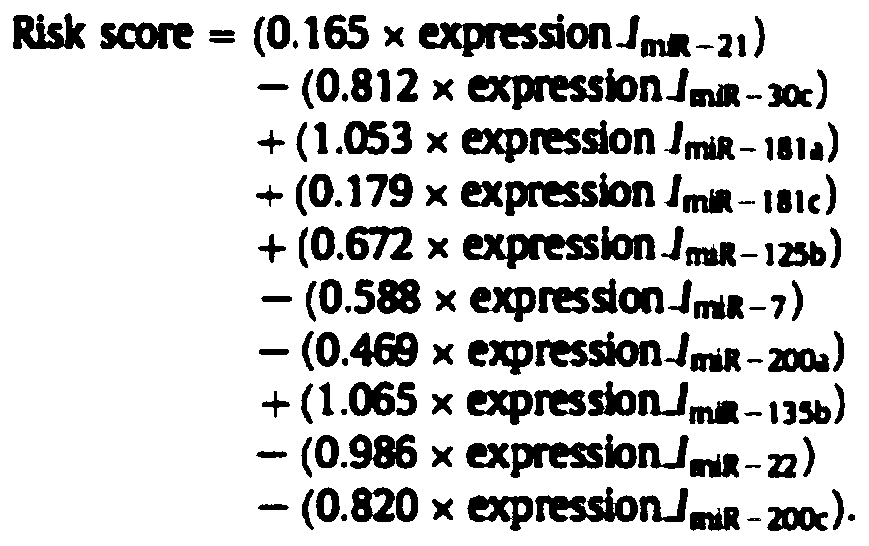Kit for predicting hormone receptor positive breast cancer preoperative chemosensitivity
A technology sensitive to hormone receptors and chemotherapy, applied in the field of biomedicine, can solve problems such as non-recommended use, pCR rate reflection, stratified analysis, etc., and achieve the effect of clinical operation convenience
- Summary
- Abstract
- Description
- Claims
- Application Information
AI Technical Summary
Problems solved by technology
Method used
Image
Examples
Embodiment 1
[0032] 1. Extraction of total RNA
[0033] (1) Removal of paraffin
[0034] Add 2ml xylene (self-prepared) to a 5ml centrifuge tube containing paraffin tissue, vortex for 10 seconds; transfer the tissue and xylene mixture to a 2ml centrifuge tube (AXYGEN MCT-200-C), centrifuge at 12000rpm for 2min at room temperature, Gently pour off the supernatant, be careful not to remove the precipitate; add 1.5ml of xylene again, vortex for 10 seconds; centrifuge at 12000rpm at room temperature for 2min, gently pour off the supernatant, be careful not to remove the precipitate; add 1ml of absolute ethanol (prepared by yourself), Vortex and mix well, and centrifuge at 12,000rpm for 2 minutes at room temperature; pour off the supernatant gently, and be careful not to remove the precipitate. If white paraffin remains on the upper layer of the precipitate, add 1.5ml xylene again, vortex for 10 seconds, centrifuge to remove the supernatant, do not remove Precipitate; add 1ml of absolute ethan...
Embodiment 2
[0069] According to the operation method of Example 1, the pre-NAC baseline tumor puncture paraffin specimen was used to calculate the risk score (risk score, RS) of each HR-positive early breast cancer sensitive to preoperative chemotherapy. The RS distribution of 285 patients is as follows: figure 2 As shown, the ordinate of the distribution graph is the RS score, and the abscissa represents the number of patients. The specific RS scores of each enrolled patient are arranged from left to right in ascending order, and the median value of RS is 2.062 (range: - 3.753 to 7.781). figure 2 The black dots represent non-pCR patients, and the gray dots represent pCR patients. figure 2 It can be seen that the density of gray dots is densely distributed in places with high RS scores, suggesting that the higher the RS score, the more sensitive chemotherapy is, and the easier it is to obtain pCR.
[0070] Using the continuous variable 10-miRNA RS as a predictor, the logistic model wa...
Embodiment 3
[0073] In order to facilitate the qualitative assessment of the chemotherapy sensitivity of patients with pseudo-NAC in clinical practice, we further select an optimal cut-off value (cut-off) for the 10-miRNA RS model, and transform the continuous RS into a binary variable, which is more helpful Clinicians make treatment decisions. In order to select the optimal cut-off value, we used the grid search method, and performed chi-square test, Fisher's exact test and logistic regression analysis on RS with different cut-off values through R language programming, and observed each possible RS value as the cut-off value prominence at the time. Specific results such as Figure 4 It shows that the abscissa is the specific RS cut-off value, the ordinate is the P value, and the dotted line is the reference line with the P value less than 0.05. The machine performs calculations in the range of RS equal to 0 to 5, and the RS value below the dotted line is used as the cut-off value , th...
PUM
 Login to View More
Login to View More Abstract
Description
Claims
Application Information
 Login to View More
Login to View More - R&D
- Intellectual Property
- Life Sciences
- Materials
- Tech Scout
- Unparalleled Data Quality
- Higher Quality Content
- 60% Fewer Hallucinations
Browse by: Latest US Patents, China's latest patents, Technical Efficacy Thesaurus, Application Domain, Technology Topic, Popular Technical Reports.
© 2025 PatSnap. All rights reserved.Legal|Privacy policy|Modern Slavery Act Transparency Statement|Sitemap|About US| Contact US: help@patsnap.com



